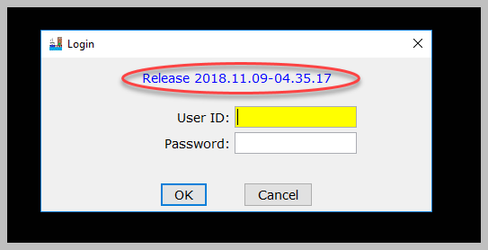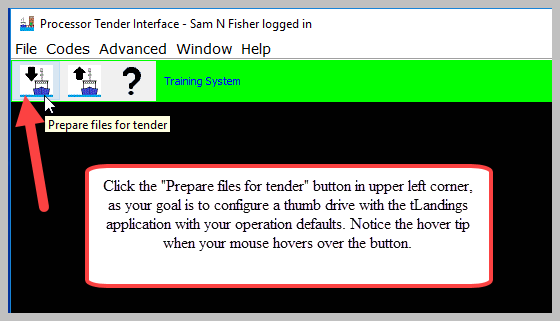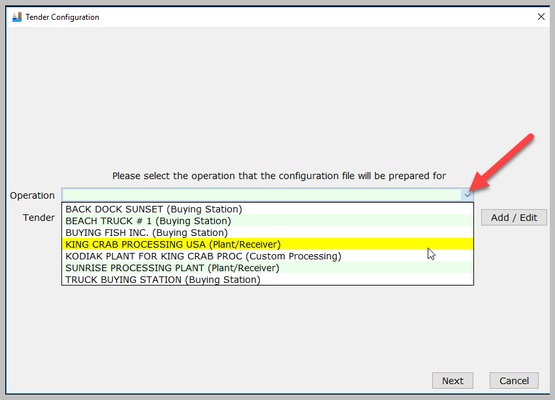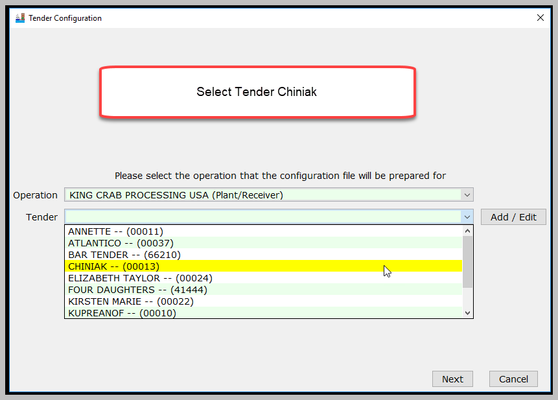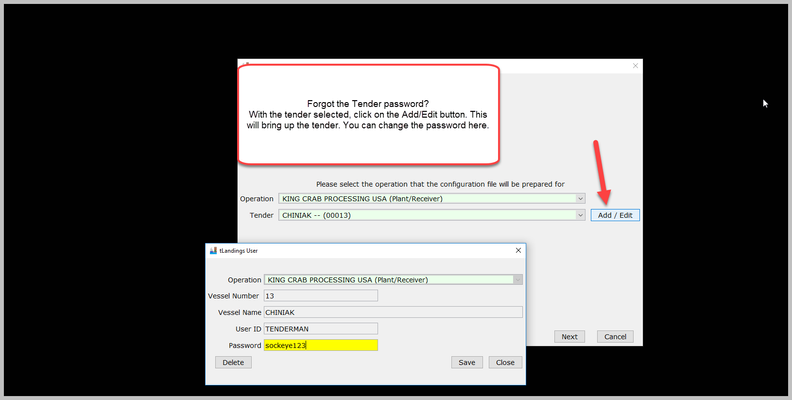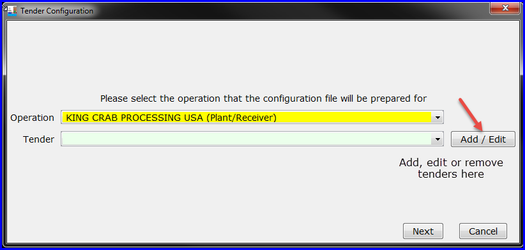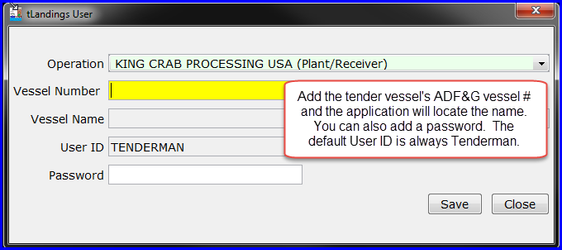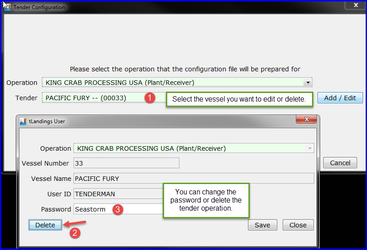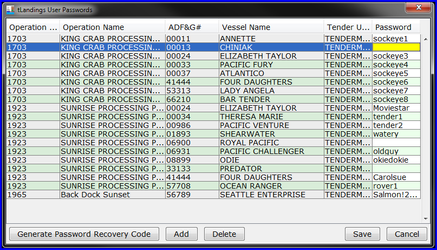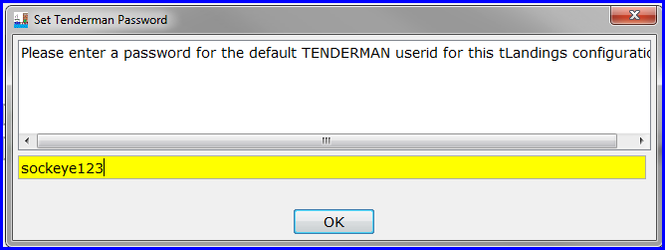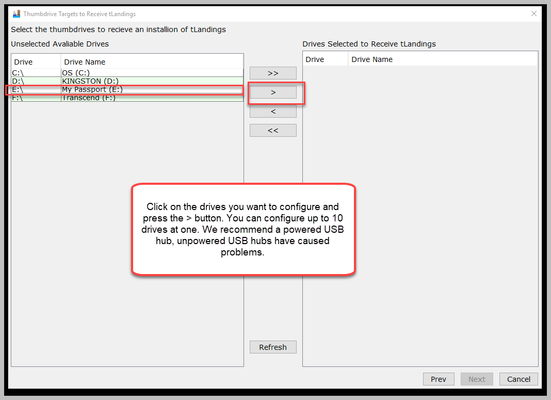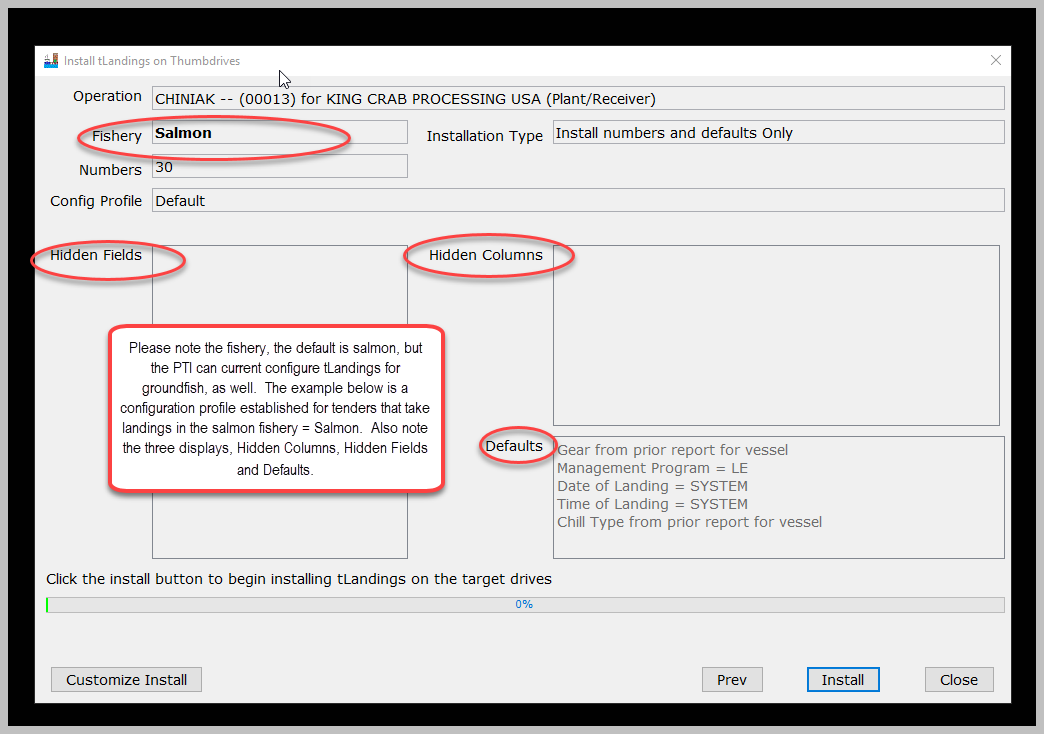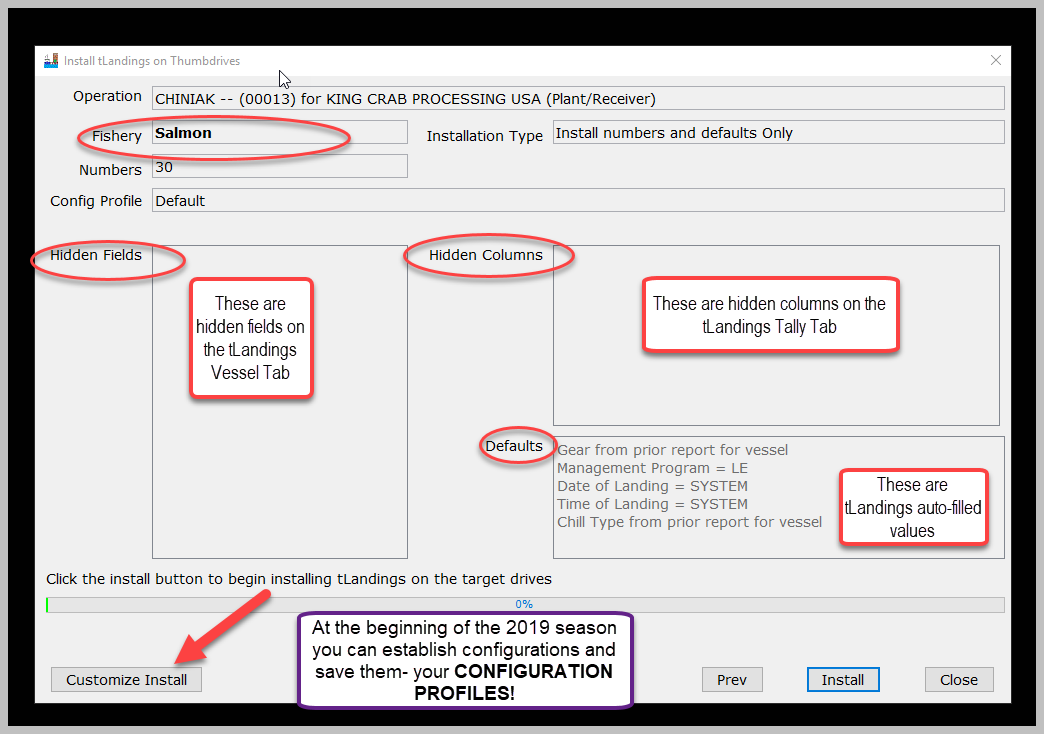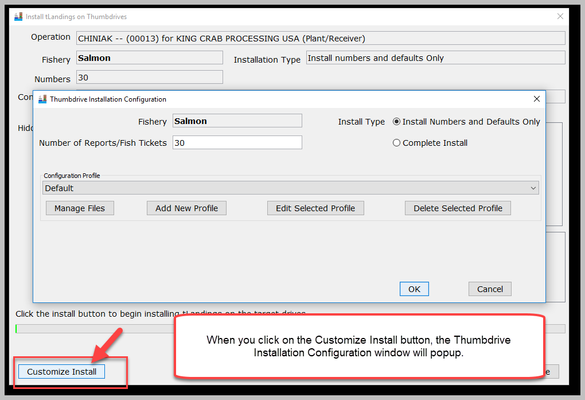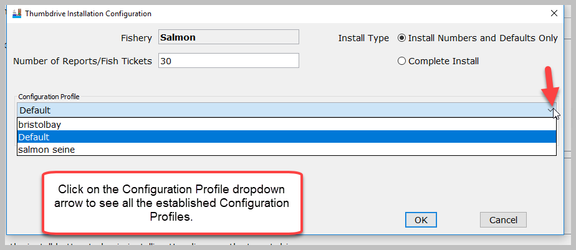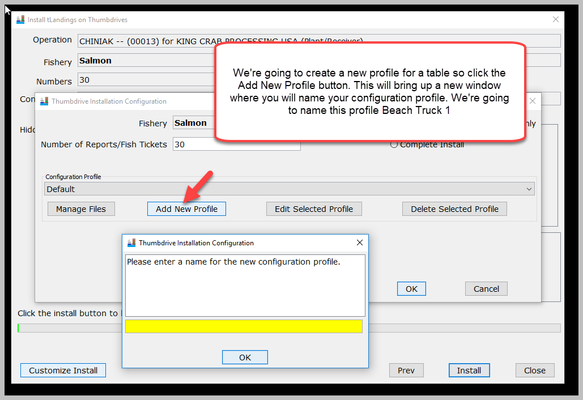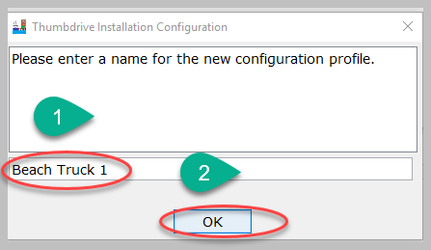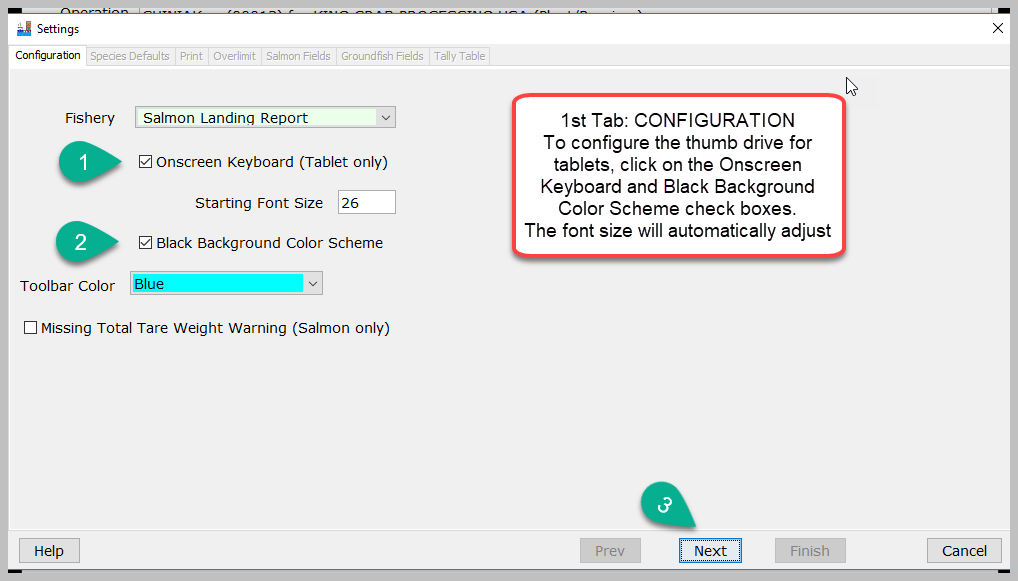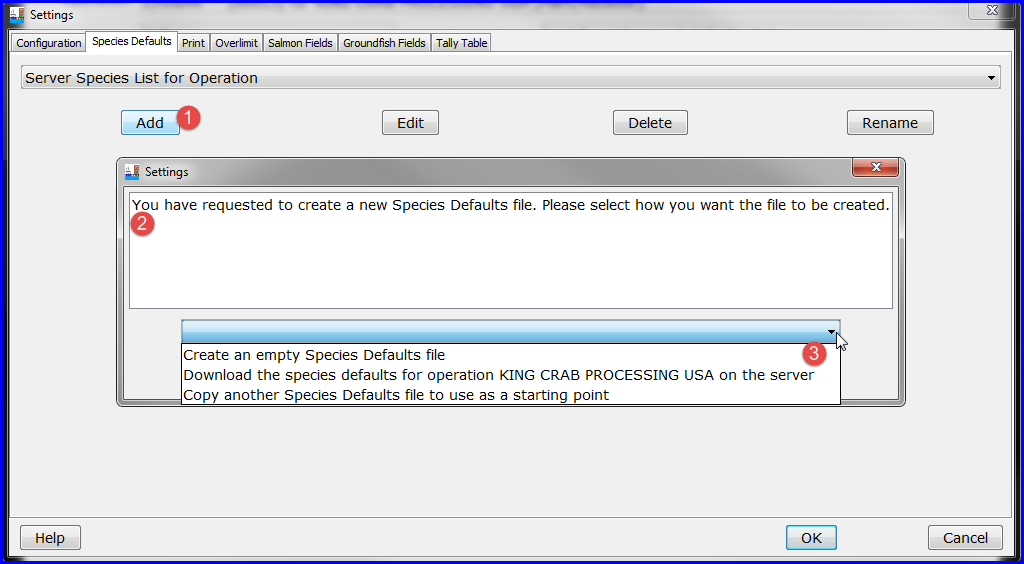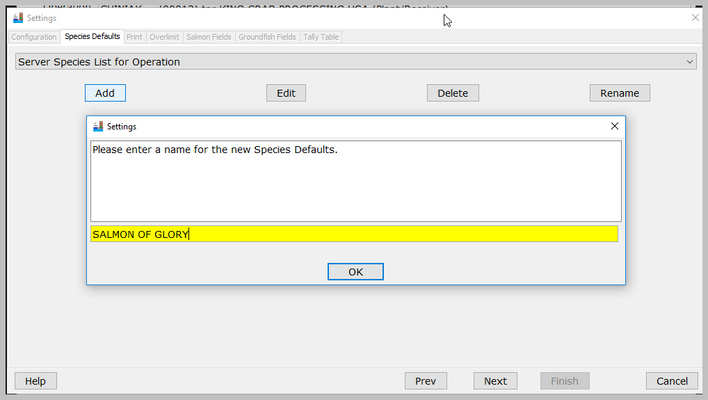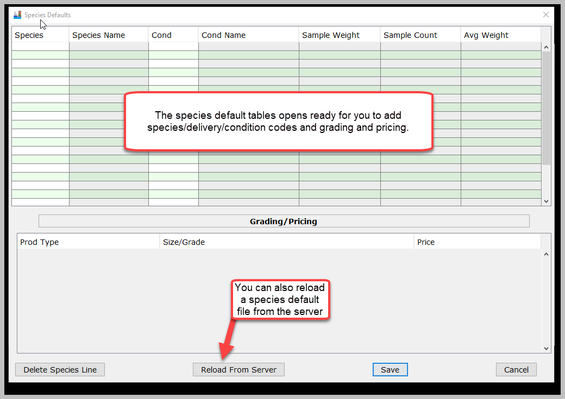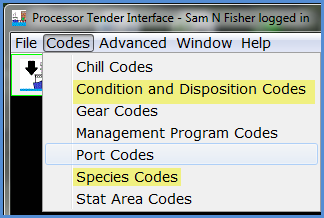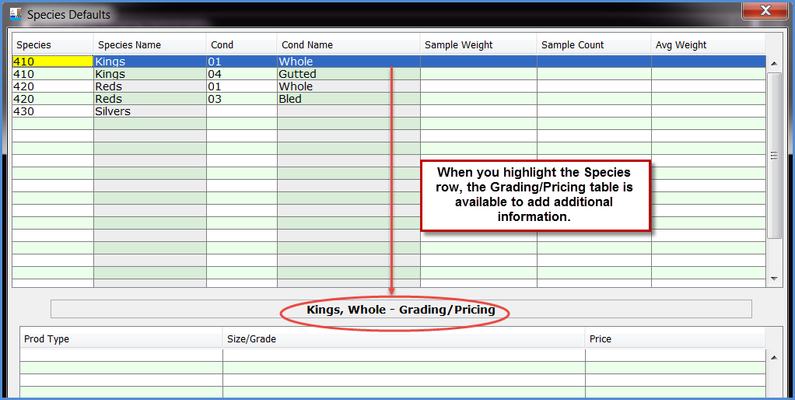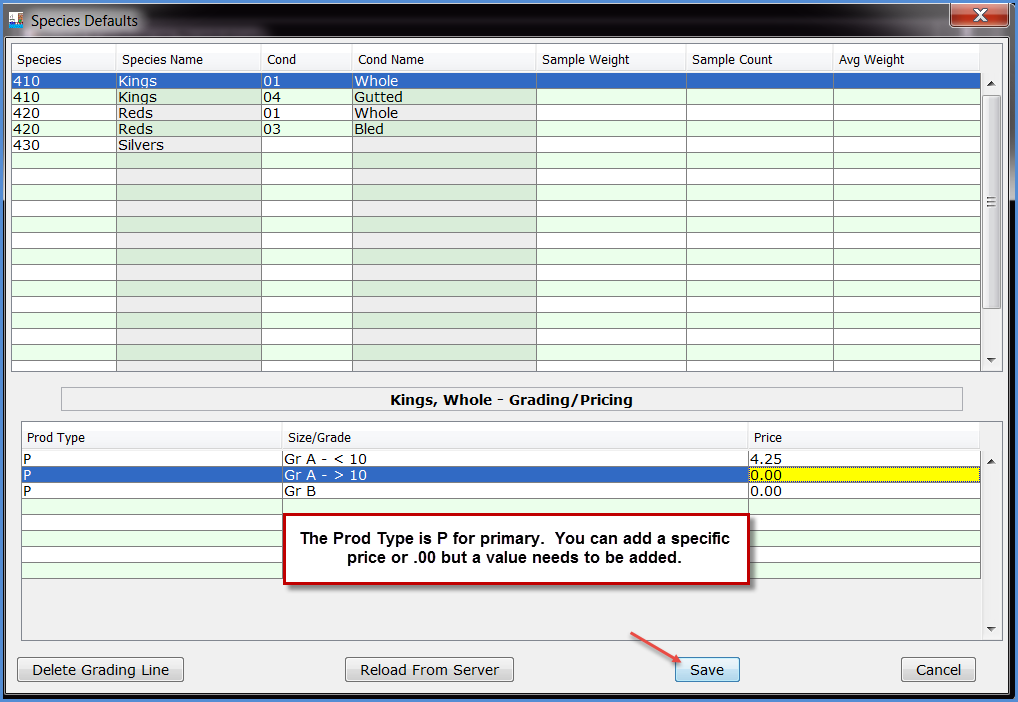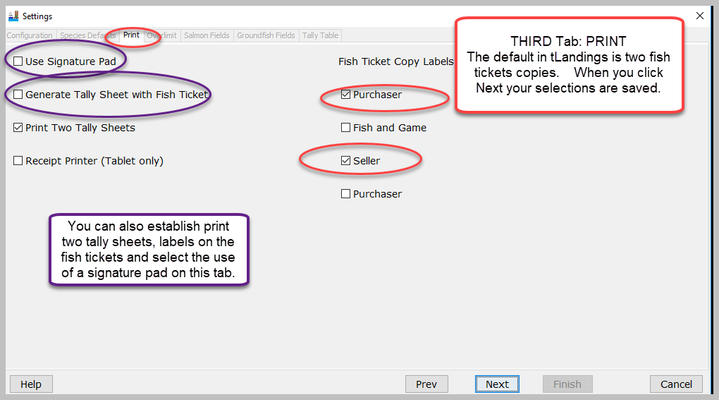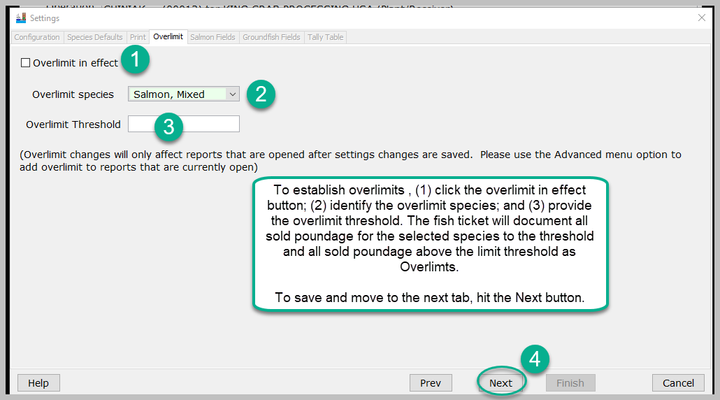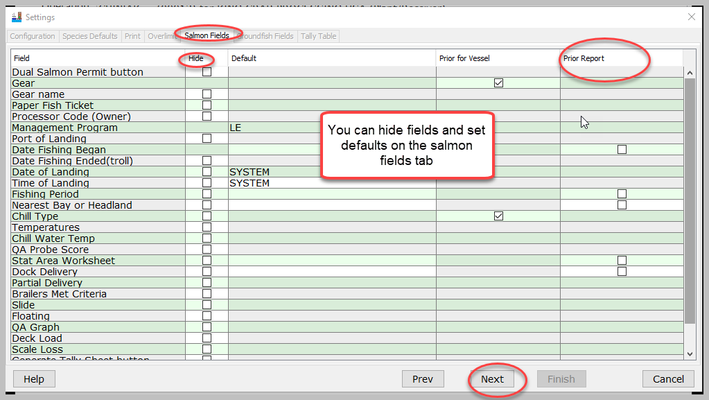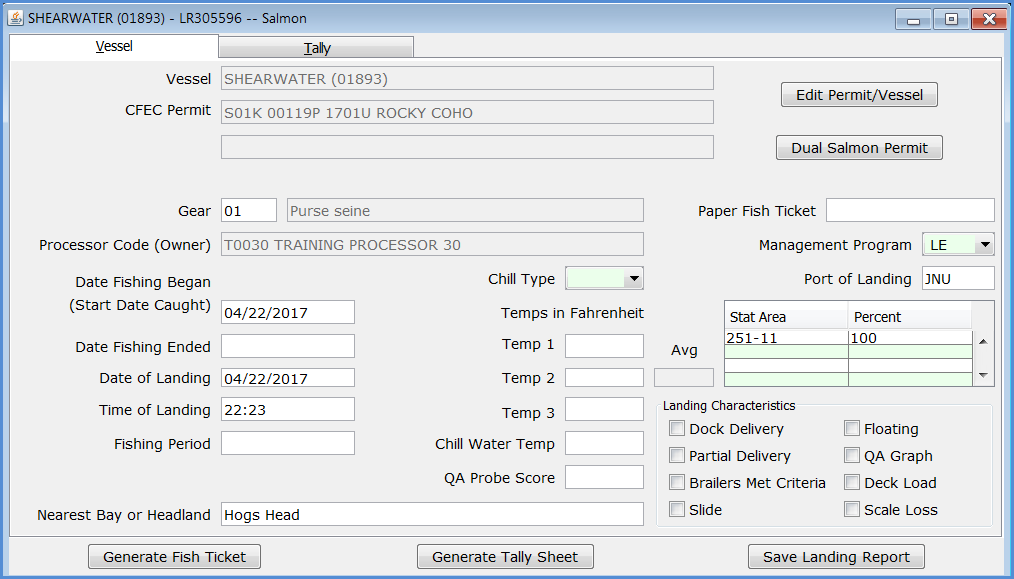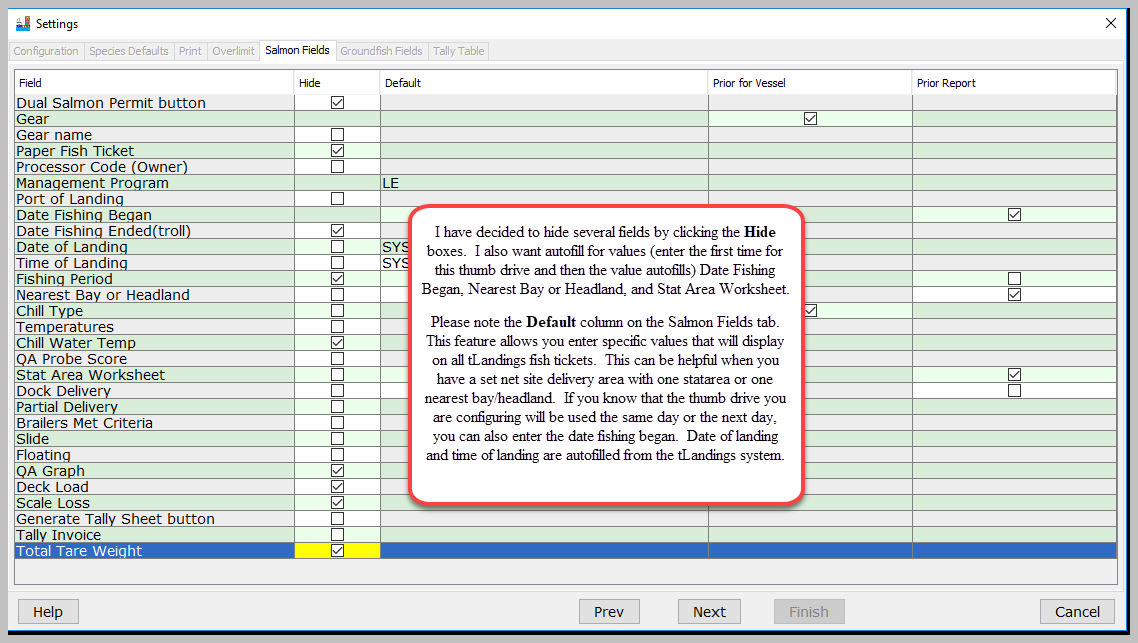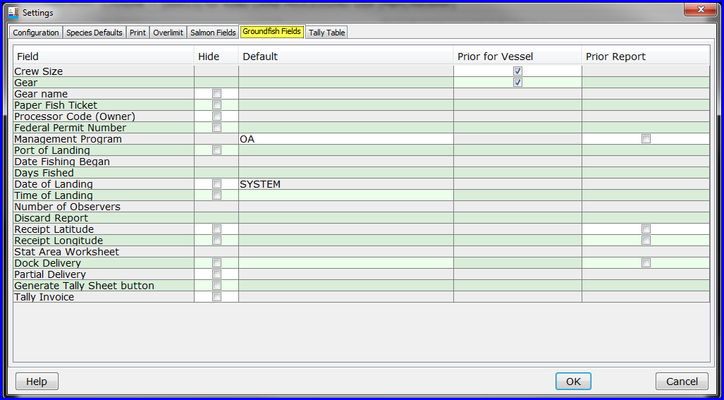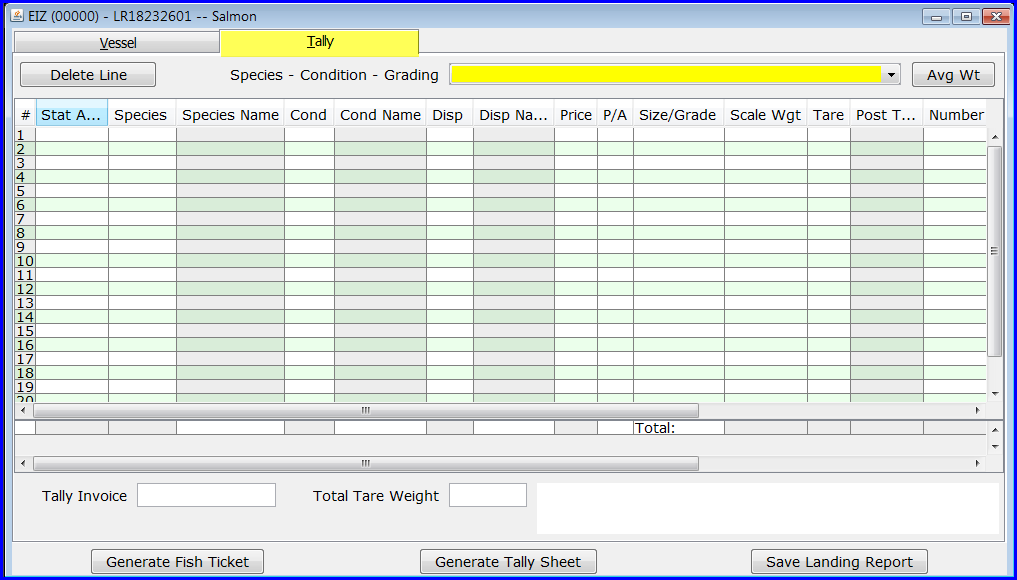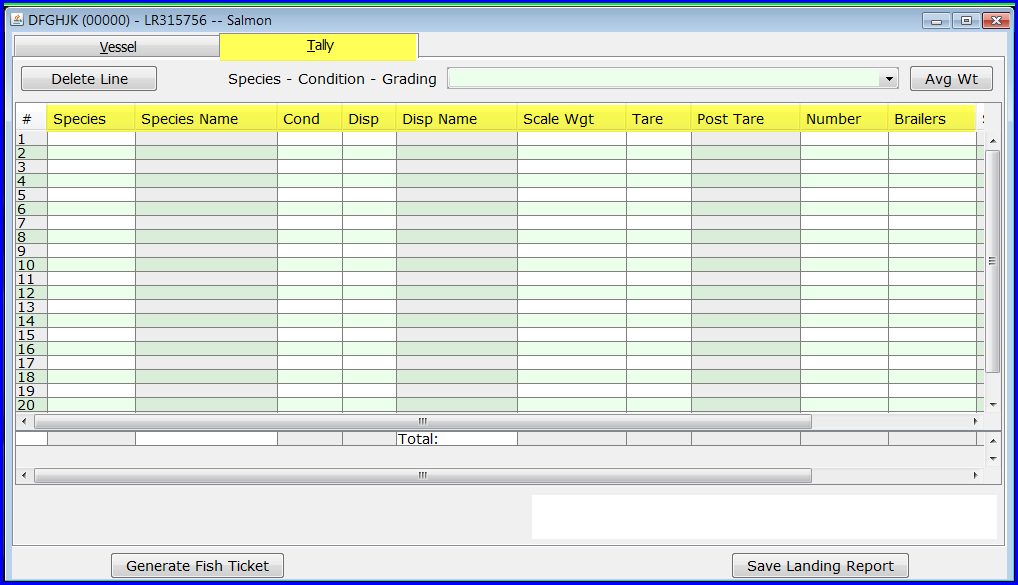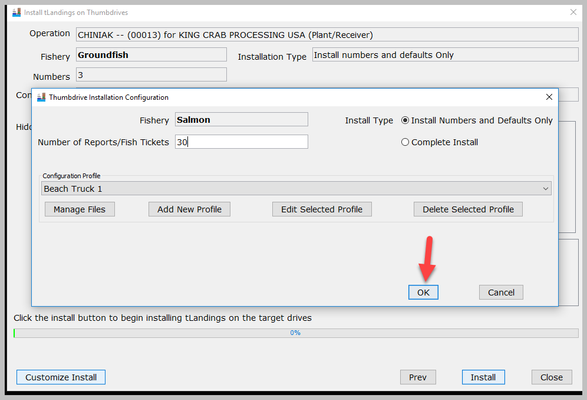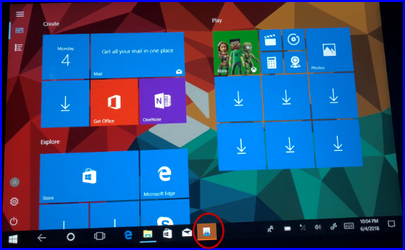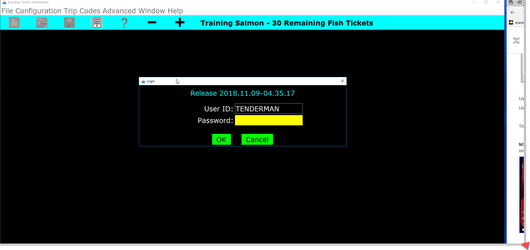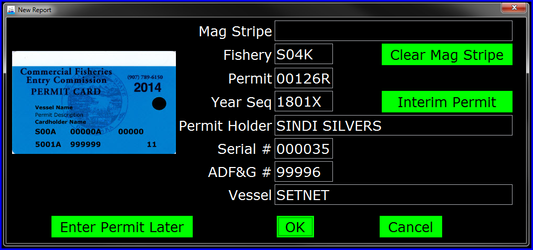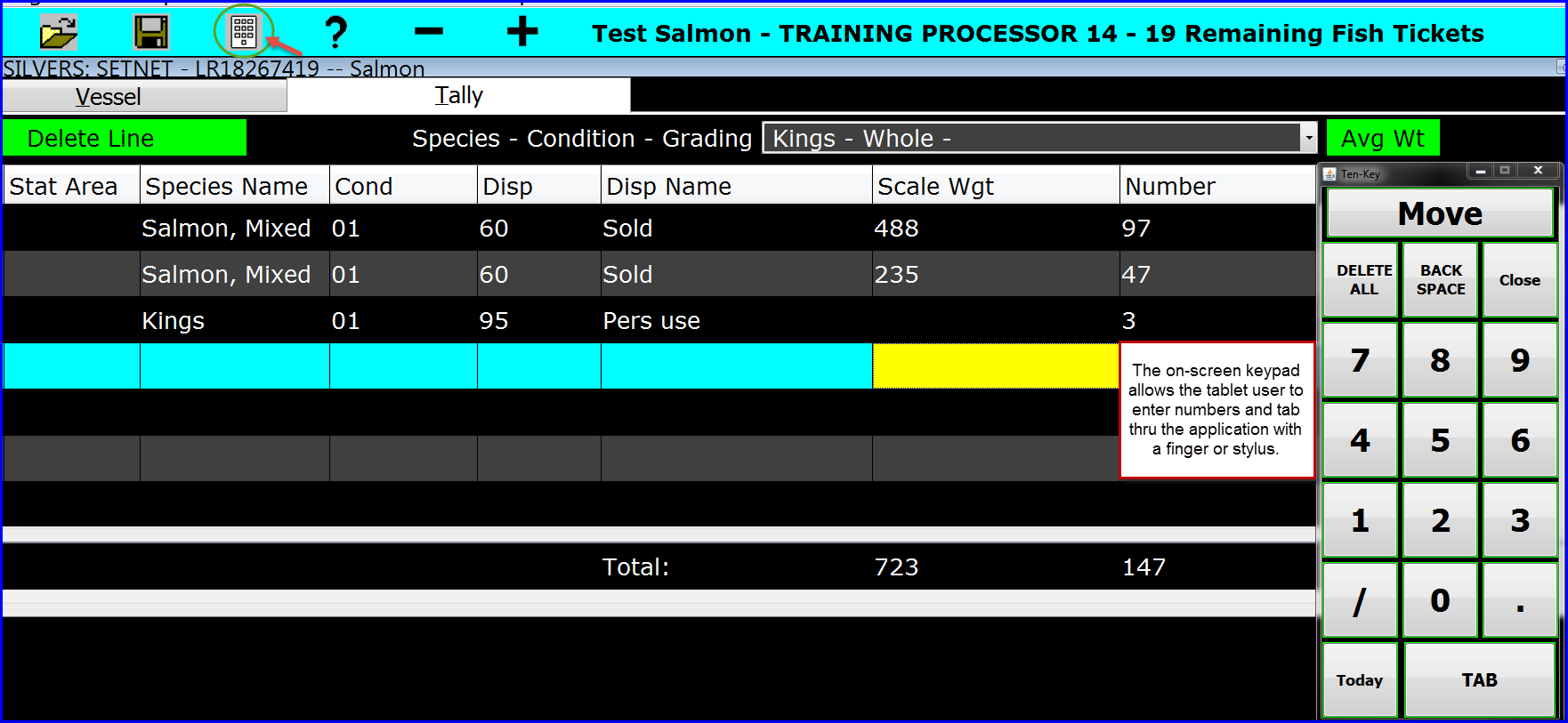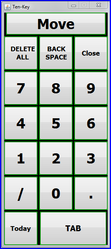eLandings User Manual
PTI Scenario 4 – tLandings Tablet Configuration
User ID and Password to Use for this Exercise
User ID: sfish
Password: sockeye1
To complete this exercise, you will need:
To complete this exercise you will need to have the Processor Tender Interface, 2019 TRAINING 2025 PTI Download Instructions downloaded to your workstation or laptop and one unformatted (empty) tLandings thumb drive inserted into a USB port.
Scenario
You are the fish ticket front office person for King Crab Processing. In this practice exercise you will prepare a thumb drive for the eLandings tender CHINIAK, ADF&G 00013. As part of the configuration you will create a configuration profile for tenders that do not price the product delivered. You will also establish the species and delivery conditions used by your company. The configuration profile you create will be saved and available for selection and use in the future.
Insert an empty thumb drive in a USB port in your workstation, and note the drive letter assigned to it in My Computer.
Locate the Processor Tender Interface (PTI) from the icon on your desktop. When you download and install the PTI, an icon will be placed on your desktop.
Please use the PTI Training application for the current year.
LOGIN
Double click the icon to open up the Training PTI. Notice the Release number. Login as sfish, password sockeye1.
Prepare Files for Tender
Click the "Prepare files for tender" button in upper left corner, as your goal is to configure a thumb drive with the tLandings application with your operation defaults. Notice the hover tip when your mouse hovers over the button.
The PTI operates as a wizard, guiding you through the steps to configure the thumb drive, screen by screen. Most prompts will be NEXT buttons in the lower right-hand corner. When you click on the down arrow boat icon (Prepare files for tender), a dialog box, Tender Configuration, opens with a list of all operations associated with your eLandings user account. You may only have one operation to select.
Once you select the operation, select the tender to begin the configuration process.
Select King Crab Processing Plant from the drop down list of operations
NOTE: As you review the Operations, you will see listed plant/receiver facilities, buying station, and custom processing relationships.
If you select a buying station, no tenders are listed. Configure the thumb drive with the selected buying station only. If you have a custom processing relationship with another facility (operation) and it includes tenders, these will be listed.
If your operation shares tenders with another plant operation (sister facility), when you select the operation, the tenders associated with that operation will be listed. Tenders shared with another plant operation will be listed if they have been added to your operation. Tender operations can also be managed from the eLandings web application, under Administer Operations.
Select the tender, Chiniak (00013).
Forgot the Tender password?
If you forgot the tender password, on this screen, with the tender selected, click on the Add/Edit button.
Want to Add a Tender?
Click on the Add/Edit button. Note the highlighted yellow field. This is a standard navigation tool within the PTI and tLandings telling you that this is the cursor focus – ready for typing or selection.
If you select a tender and then click on Add/Edit, you will be able to change the password or delete the tender operation.
Manage tLandings User Passwords
Another resource for both tender and tender password management is the Manage tLandings User Passwords, located under the Advanced menu.
This dialog box allows you to add or delete tenders and manage tender passwords.
I have not set up a password for a specific tender operator, so a dialog box opens and asks for a password. Please remember that passwords are case sensitive.
The tender is called Chiniak and I give the tender operator the password: sockeye123 and click OK.
I have my Operation and Tender Selected!
With the operation and tender selected, click on the Next button in the lower right hand corner.Select the USB drive letter for the thumb drive(s) and click the right arrow button to add it to the list of target drive(s) names. Click Next to continue.
Select the USB port(s) and then click the > arrow. You can configure up to 10 drives at once, so you can select more than one USB port.
Once you've selected your drives to receive tLandings, click the Next button.
Install tLandings on Thumbdrives
This will bring you to the Install tLandings on Thumbdrives window. Please note the fishery, the default is salmon, but the PTI can current configure tLandings for groundfish, as well. The example below is a configuration profile established for tenders that take landings in the salmon fishery = Salmon. Also note the three displays, Hidden Columns, Hidden Fields and Defaults. We will review how these tables are used in this exercise.
Customizing the Installation of tLandings with tLandings Profiles
At the beginning of the season you can create several thumb drive configuration profiles and save/store for use throughout the current and future seasons. Customized Configuration Profiles are available for both groundfish and salmon. You will need to complete a Customize Install to create a configuration profile. Profiles are stored and can be edited or deleted at any time.
When you click the Customize Install button, a new dialog box opens, Thumb drive Installation Configuration. Please take a minute to review this box and note the Number of Reports/Fish Tickets. In the example the default number is 30, but you may need to install many more unique fish ticket/landing report numbers.
We're going to customize this installation for a tablet, so click on the Customize Install button. When you click on the Customize Install button, the Thumbdrive Installation Configuration window will popup.
The configuration proles is set to Default. Click on the Configuration Profile dropdown arrow to see all the established Configuration Profiles.
The most recently used profile displays first, which here is bristolbay. I have two other profiles, Default and Salmon Seine. Yours might be different depending on who was last using this training login.
Each profile can contain the follow customizations:
- Customized hidden fields (Vessel Tab)
- Customized hidden columns (Tally Tab)
- Unique species lists for salmon and groundfish, as well as salmon troll.
- Default values can be establish with any profile, but should be used very carefully.
- Default values from the prior landing report can also be established in the profile.
- The number of reports/Fish Tickets can be defaulted to a specific number or modified with each thumb drive configuration.
For this training scenario you will select the button titled: ADD NEW PROFILE.
CONFIGURATION OF A THUMB DRIVE FOR A TABLET DEVICE
Tablet devices, by design, have a smaller display screen. They are well suited to simpler fisheries, such as set gillnet and drift gillnet fisheries, with fewer statistical areas, fewer lines of itemized catch and no pricing.
We're going to create a new profile for a table so click the Add New Profile button. This will bring up a new window where you will name your configuration profile. We're going to name this profile "Beach Truck 1"
Enter the name Beach Truck 1 and hit the OK button.
This will bring up the Settings window.
The Settings window with seven tabs will display. We will review each tab.
Configuration Tab
1. Configuration – allows you to select the fishery – salmon or groundfish and the reporting platform – laptop or tablet. The default font size for the laptop is 14. You can also change the toolbar color and if a Bristol Bay fishery, check the Missing Total Tare Weight Warning. The Black background color scheme is only recommended if you use a tablet. You can change the Toolbar Color as well here. Above, we have it changed to Blue.
The Starting Font Size for the tablet configuration is 26. If you are using a Mobil Demand tablet, this font size is correct. If using a BAC USA tablet, adjust the Starting Font Size to 22.
Once you've checked the boxes, click the next button to move onto the second tab, Species Defaults.
Species Defaults Tab
2. Species Defaults – allows you to manage species lists customized for specific fisheries and store unique species lists.
When you click on the Add button a dialog box opens and request that you decide how you want to obtain the new Species Default – create a new one, download from eLandings or copy another species default from a stored profile. We will choose to Create an empty Species Default file.
As this is a new Species Default, you will first need to provide a name. Please name your profile with a unique name, like your own name, as many end users will use this exercise. Here I named my new species default fil "SALMON OF GLORY". Hit the OK button.
Once you click the OK button, the Species Default table will open.
Determine the species, species codes and delivery conditions that will be represented in the deliveries this tender will encounter. Remember, to keep it as simple as possible. Your company may have many different species delivery conditions and size/grade categories, but you need to ask yourself, are they delivered to your tender fleet?
Using the species codes and delivery condition codes, type in the Species code, tab to the delivery Cond and enter the code and tab to the next row. Notice that the text will autofill. All codes are easily available from the PTI Codes, dropdown menu.
The Average weight should not be established by the seafood plant staff. Area management biologists want the average weight by species and delivery condition to be established at the beginning of each opener. These fields are intended to display the established values.
When you have completed the Species/Delivery Condition Defaults, you are ready to add any grading or pricing needed.
You can add price or leave all deliveries unpriced. If you do not want to price deliveries, you will need to enter a value, which is “.00”.
You do not need to record any grading/pricing information. This is optional. Prices can be changed by the tender operator, in tLandings, while on the fishing grounds.
Once I have saved the file, the PTI automatically returns to the Settings page – Species Default tab.
In the illustration below sfish (Sally Fisher) has three Species Default tables. Go ahead and click NEXT button to go to the Print tab.
3. PRINT TAB
The default in tLandings is two fish tickets copies. You can also establish print two tally sheets, labels on the fish tickets and select the use of a signature pad on this tab. When you click Next your selections are saved.
NOTE: We suggest you set all tender based printers to Draft quality, which is sufficient to print a legible fish ticket and/or tally sheet.
4. OVERLIMITS TAB
Seafood office staff can establish overlimits, as well as tender operators.
To establish overlimits , (1) click the overlimit in effect button; (2) identify the overlimit species; and (3) provide the overlimit threshold. The fish ticket will document all sold poundage for the selected species to the threshold and all sold poundage above the limit threshold as Overlimts.
To save and move to the next tab, hit the Next button
.
5. SALMON FIELDS TAB
The Salmon Fields - tab allows you to customize the display of tLandings to simplify reporting and display only those data fields ADF&G and your company to complete. If you choose Salmon as the fishery, the wizard will display this field.
Below is the default display for tLandings without any hidden fields. Please review this display and ask yourself, “what fields can I hide to make the data entry for tender staff easier?”
I have decided to hide several fields by clicking the Hide boxes. I also want autofill for values (enter the first time for this thumb drive and then the value autofills) Date Fishing Began, Nearest Bay or Headland, and Stat Area Worksheet.
Please note the Default column on the Salmon Fields tab. This feature allows you enter specific values that will display on all tLandings fish tickets. This can be helpful when you have a set net site delivery area with one statarea or one nearest bay/headland. If you know that the thumb drive you are configuring will be used the same day or the next day, you can also enter the date fishing began. Date of landing and time of landing are autofilled from the tLandings system.
Note: Default values and Prior Report values can be extremely helpful is simplifying reporting, but it can also populate multiple fish tickets with incorrect information. These features are not appropriate for tenders that take deliveries from catcher vessels harvesting in multiple statistical areas.
6. GROUNDFISH FIELDS TAB
If you choose Groundfish as the fishery, this is the next tab the wizard will display. You are configuring the thumb drive for salmon in this exercise, but please be aware that the PTI not only supports groundfish, but also allows you to customize fields on the Vessel tab.
7. TALLY TABLE TAB
Tally Table – is the last tab, used to customize fields in both groundfish and salmon. This screen allows you to hide columns that are not needed for the activity of the tender. Below is the standard display for the Tally page in tLandings.
The display of columns is now simplified. The tender operator completing fish tickets do not need to guess what columns are important and what columns can be ignored.
Once you have made the selections on the last tab of the Settings window you are ready to configure thumb drives with the tLandings application, your operation information (processor code, port, etc.), 30 fish ticket/landing report numbers, and the Configuration Profile you just completed. Click OK to close the Thumbdrive Installation Configuration window.
Prior to install you should review the Config Profile name and the hidden fields, columns and defaults. If correct, select Install.
This Configuration Profile can be used for one or many salmon seasons. If you want or need to edit the profile, it is easy to do.
Click Install and then once the installation completes.
Click Close, to close the installation dialog. The thumb drive is now ready to use.
Open and Review the Tablet Configuration tLandings Application
Using the My Computer tool, click on the thumb drive you just configured, you will see that it is configured for the Beach Truck # 1 for KING CRAB PROCESSING PLANT using tLandings training.
Using the stylus, double click on the icon run_tlandings in front of the run_tlandings file.
The first thing you will notice is the black background and white text, designed to reduce sun glare with the tablet.
NOTE: If you are using a BAC USA Seal Tablet, this machine uses Windows 10 with a tablet mode. When you insert the configured thumb drive into the USB port, the file structure of the thumb drive is displays, as shown below. Using the stylus, click on the icon in front of the run_tlandings file. The application starts in approximately one minute. A tLandings icon will appear in the taskbar of the tablet.
The tLandings application will open. Enter the password you created for your tender when configuring the thumbdrive.
Click on the icon, Create a New Landing.
The CFEC Permit dialog box will open.
Once the permit is recorded the Vessel page will open.
NOTE: If you are able to correctly enter default values, which is frequently the case with setnet fisheries, the tLandings application will bypass the Vessel page and open to the tally page, after the CFEC permit is recorded.
On the tally page, note the keypad icon, which will open the keypad. The keypad will allow you to enter numbers quickly. When you click the Today button, it will enter today’s date. You can move the keypad around the tablet screen by clicking the Move button. You will have 4 seconds to move the keypad.
The Tally page allows you to record the species, delivery condition, disposition, scale weight and number of fish. You can also establish the average weight, which allows for the automatic calculation of number.
eTablet supports electronic signatures which are transferred to the printed fish ticket.
Once the fisher’s and buyer’s signatures are captured, a PDF of the fish ticket is created, ready for printing.
Once you have reviewed the eTablet display, close the application and remove the thumb drive.
Please follow procedures to safely remove the thumb drive. This may be done several different ways, but the quickest and easiest method is to LEFT Click on the “Safely Remove Hardware” icon in the system tray (lower right corner of task bar).
How to Download and Print this Article as a PDF
Download:
Click the 3 dots (...) at the top right of the article
Click Export
Click Export to PDF
Wait for the PDF to load, and click Download PDF
Print:
Open the PDF
Print the PDF
Support Contact:
If you have any questions or concerns, please contact elandings@alaska.gov

